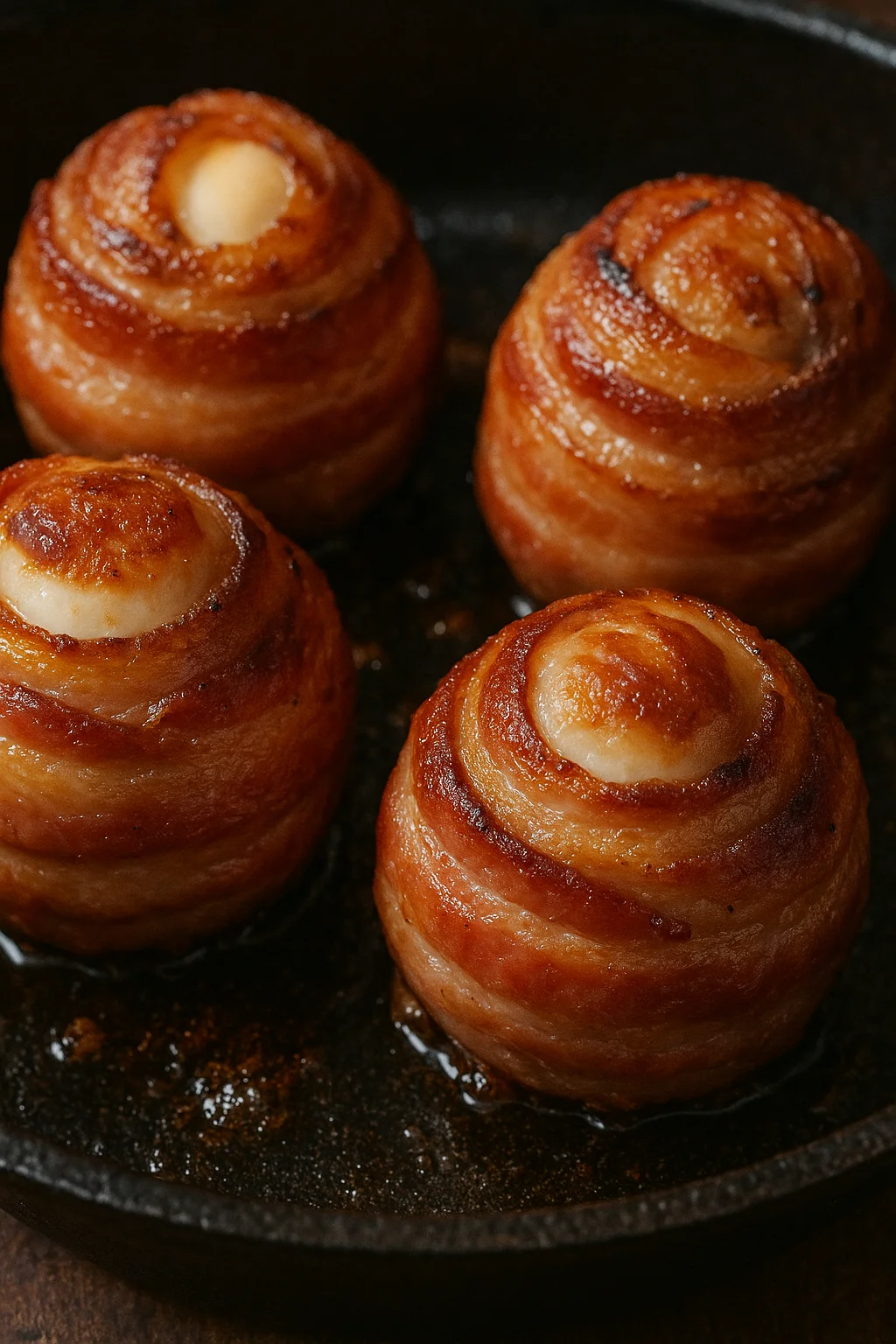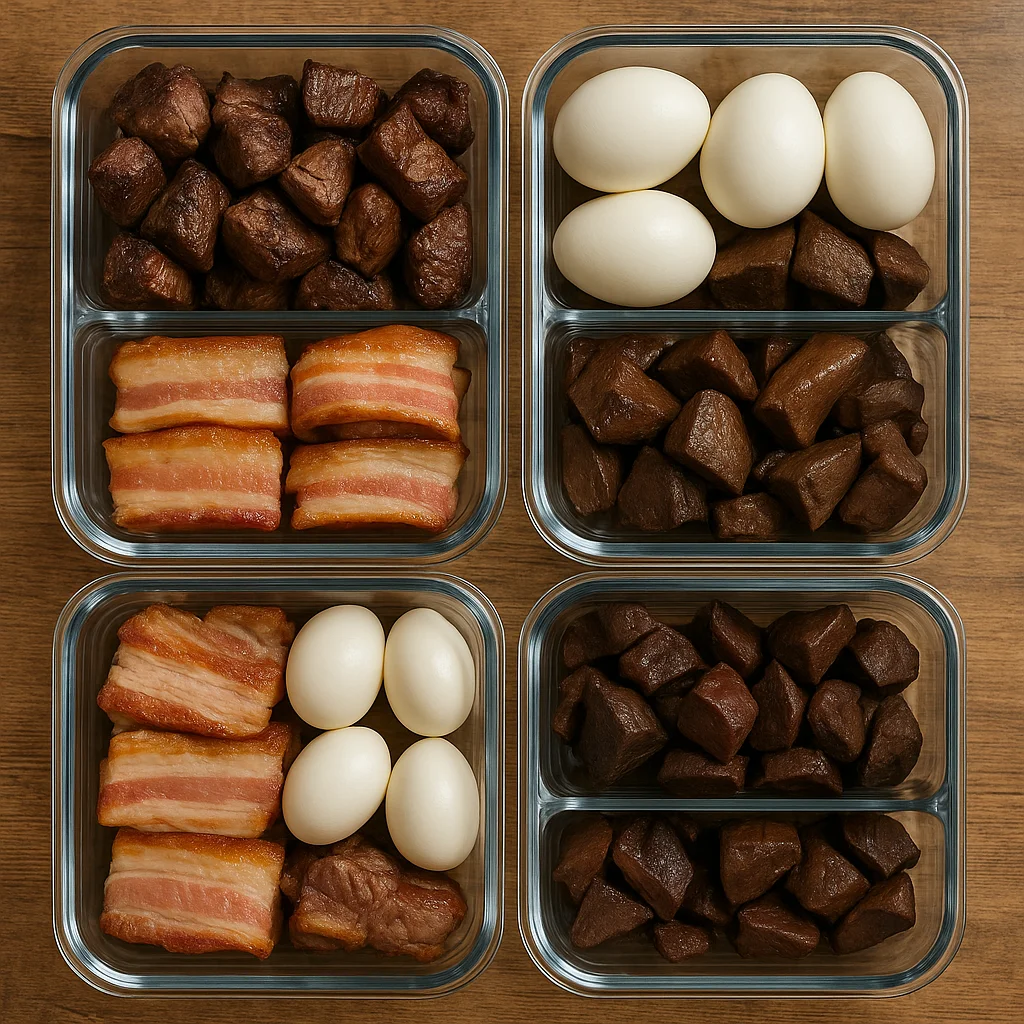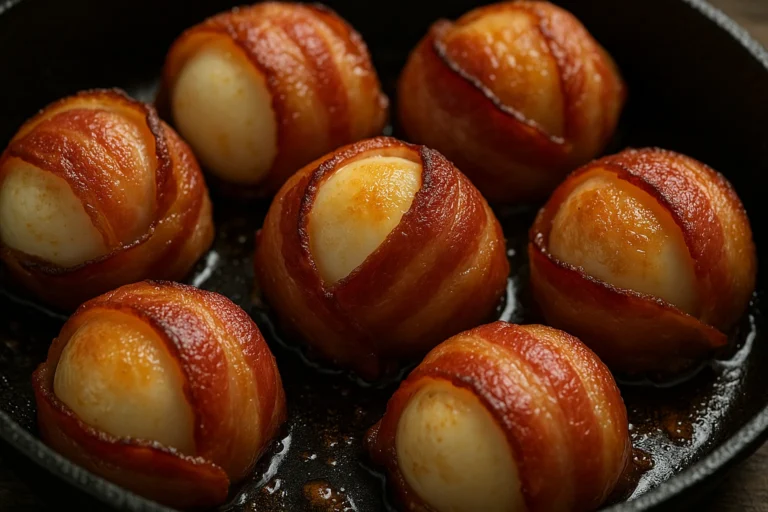If you’re tired of carb crashes, sugar spikes, and meals that leave you hungry an hour later, it might be time to switch things up. This ultimate guide to carnivore recipes is for anyone ready to embrace a meat-only diet that delivers real energy, real nutrients, and real satisfaction.
Whether you’re new to the carnivore lifestyle or a seasoned meat-lover, having a go-to list of simple, high-fat, and zero-carb meals is essential. The right carnivore recipes can help you stay consistent, avoid cravings, and feel your best every single day.

Learn more about homemade Mounjaro recipe for weight loss if you want to pair your diet with fat-burning support.
Understanding the Carnivore Diet
What Is the Carnivore Diet and How It Works
The carnivore diet is a form of elimination diet that focuses solely on animal-based products. That means your plate is stacked with meat, eggs, and sometimes dairy—no veggies, no grains, no sugar, and absolutely no carbs. The goal? To remove inflammation triggers and optimize your energy, mental clarity, and digestion by fueling your body with what it’s biologically designed to eat.
People following this diet typically consume:
-
Red meats like beef, lamb, and bison
-
Poultry such as chicken or duck (especially fatty cuts)
-
Fish and seafood, including salmon, sardines, and shrimp
-
Eggs, particularly pasture-raised or omega-3 enriched
-
Organ meats like liver and kidney for nutrient density
-
Animal fats such as tallow, lard, and bone marrow
What sets the carnivore diet apart from low-carb or keto diets is that it’s not just low in carbs—it’s virtually zero carb. By cutting out plant matter entirely, you’re eliminating lectins, oxalates, and other antinutrients that many carnivore advocates believe contribute to chronic inflammation and gut issues.
Health Benefits and Risks of Eating Only Animal-Based Foods
People switch to the carnivore diet for a variety of reasons—weight loss, chronic pain relief, autoimmune disease management, mental clarity, or simply to simplify their meals. Reported benefits include:
| Benefit | Description |
|---|---|
| 🥩 Weight Loss | High satiety from protein and fat often leads to fewer calories consumed overall |
| 🧠 Mental Clarity | Stable blood sugar and no brain fog from processed carbs |
| 💪 Muscle Gains | Easy to hit protein goals, supporting lean mass retention |
| 🛡️ Reduced Inflammation | No plant-based antinutrients triggering immune responses |
| 😌 Digestive Relief | Many see IBS, bloating, and GERD symptoms disappear |
But there are risks too. Without proper planning, you could lack certain nutrients like vitamin C, electrolytes, or fiber. Some people also report increased cholesterol levels—though whether that’s harmful depends on individual health markers and genetics. Always work with a doctor when trying a radical dietary shift.
Don’t miss our canning meats guide if you’re planning to store protein for the long haul.
What Makes a Recipe “Carnivore-Approved”?
Key Rules of Carnivore Cooking
Carnivore recipes aren’t just about throwing meat on a grill and calling it dinner. There are specific guidelines to ensure your meals stay true to the diet and support your health. Here’s what every recipe must follow:
1. No Plant-Based Ingredients
This includes no herbs, spices, garlic, onions, or even black pepper. Pure carnivore cooking avoids anything grown from the ground. While some people adopt a “relaxed carnivore” approach and use seasoning, strict carnivores stick to salt—and sometimes not even that.
2. Fat-to-Protein Ratio Matters
Your body needs fat for fuel in the absence of carbs. Ideally, a carnivore meal should maintain a fat-to-protein ratio of 1:1 by weight. That means combining lean cuts with fattier parts (like suet, tallow, or egg yolks).
3. Organ Meats Are Encouraged
Beef liver, heart, kidney, and spleen are packed with nutrients you won’t find in muscle meat alone. Many carnivores incorporate these once or twice a week to stay balanced.
4. Focus on Nose-to-Tail Eating
The best carnivore recipes come from using the entire animal: marrow bones, skin, tongue, cartilage. This not only maximizes nutrient intake but reduces waste and saves money.
5. Cook With Animal Fats Only
Ditch olive oil and coconut oil. Use tallow, ghee, duck fat, or lard instead. These fats are stable at high heat and align with the carnivore eating style.
Looking for inspiration? Try our 14 survival foods that last forever—many are meat-based and zero-carb friendly.
Allowed Ingredients vs. Avoided Ingredients
Let’s break down what goes in and what stays out of a proper carnivore recipe:
| Allowed | Avoided |
|---|---|
| Beef, lamb, pork | All vegetables and fruits |
| Organ meats (liver, heart) | Grains, legumes, nuts, seeds |
| Eggs | Herbs and spices |
| Seafood (salmon, tuna, shrimp) | Cooking oils (olive, canola, etc.) |
| Animal fats (tallow, lard) | Dairy (unless tolerated – controversial) |
| Bone broth | Sugar, sweeteners, sauces |
Pro Tip: Some followers include raw dairy like heavy cream, raw cheese, and butter if well-tolerated. This is often called the “ketovore” approach.
Discover great ideas like survival recipes if you’re building a long-term meat-based eating strategy.
Easy Carnivore Breakfast Ideas
Classic Steak and Eggs Combos
When it comes to carnivore breakfasts, “lkelma.
“steak and eggs reign supreme. Not only are they packed with protein and healthy fats, but they’re also incredibly satisfying and quick to prepare. Here are a few go-to combos to spice up your morning routine (without breaking carnivore rules):
-
Ribeye + Fried Eggs in Tallow: A thick ribeye pan-seared in beef tallow and paired with two fried eggs—simple, fatty, and perfect.
-
Sirloin Tips + Scrambled Yolks: Ideal if you prefer leaner meat. Add butter or suet to increase fat.
-
New York Strip + Poached Eggs: For a tender and elegant breakfast. Season with Redmond Real Salt if needed.
-
Carnivore Egg Muffins: Mix ground beef and eggs, bake in muffin tins with bacon lining. Portable and prep-friendly.
This combo gives you a rich serving of B vitamins, omega-3s (if using pastured eggs), and iron—all while staying completely animal-based.
Want more off-grid cooking tips? Check out off-grid water systems for homestead to pair your meals with sustainable living.
Bacon Bombs, Liver Sausages & Organ-Meat Omelets
If you’re looking to upgrade your morning plate with more nutrient density, organ meats are your secret weapon.
-
Beef Liver Sausage Patties: Grind liver with ground beef (80/20), shape into patties, and pan-fry in lard. Freeze extras for quick breakfasts.
-
Carnivore Bacon Bombs: Wrap hardboiled eggs in pork sausage and bacon. Bake until crispy. They reheat well and are perfect for meal prep.
-
Organ Omelets: Mix chopped heart, liver, or kidney with scrambled eggs and cook in ghee. A powerful start to the day.
-
Carnivore Scotch Eggs: Similar to bacon bombs, but coated in ground beef or lamb. Air fry or bake for a crispy texture.
These recipes help prevent micronutrient deficiencies—especially iron, zinc, and retinol—and keep your gut calm by sticking to pure animal foods.
Don’t skip micro homesteading tips if you’re building a lifestyle around simplicity and self-reliance.

Mouthwatering Carnivore Lunch Recipes
Ground Beef Bowls, Burgers Without Buns
Lunchtime on the carnivore diet doesn’t mean boring or bland. With the right cuts and cooking techniques, your midday meal can be as satisfying as a steakhouse dinner—minus the carbs.
Here are lunch-friendly ideas built around ground meats and bun-less formats:
-
Carnivore Beef Bowl: Cook 80/20 ground beef in tallow, top with soft-boiled eggs and crumbled bacon. Sprinkle salt and serve in a bowl.
-
Cheddar-Stuffed Burger Patties (for relaxed carnivores): Ground beef patties filled with raw cheese, cooked in ghee for extra fat.
-
Burger Steak Stack: Stack 2–3 burger patties and drizzle with melted bone marrow.
-
Carnivore Taco Shells: Bake parmesan cheese into crisp cups, fill with pulled pork or minced lamb (only for those who tolerate dairy).
Burgers are one of the most meal-prep-friendly carnivore foods, and you can cook a week’s worth in under 30 minutes.
Don’t miss our related post on canning meats for long-term protein storage ideas.
Quick Ribeye Strips, Pork Chop Packs & Leftovers Reimagined
If you’re cooking lunch fresh, opt for thin cuts and high-heat methods to minimize time without sacrificing flavor. These carnivore recipes are quick, satisfying, and ideal for meal prepping during a busy week.
-
Seared Ribeye Strips: Slice ribeye into thin ribbons and flash sear in a cast iron skillet with tallow. Serve over a marrow base for extra fat and flavor.
-
Pork Chop Packs: Bake thick-cut pork chops in a tray with butter, bacon ends, and fatty trimmings. These carnivore meal prep recipes can cover five days in under an hour.
-
Carnivore Casserole (No Fillers): Layer leftover shredded meats with eggs and bake until golden. Optional: add raw cheddar or heavy cream if tolerated for a keto-carnivore twist.
-
Roast Beef Wraps: Use thin-sliced roast beef to wrap around hard-boiled eggs or ghee-fried liver. These portable, zero-carb lunch ideas are rich, fatty, and satisfying.
Pro Tip: Always balance your cuts—if using lean meats, add fat through yolks, suet, or marrow to hit your macro goals and maintain energy on a strict carnivore plan.
Dinner Recipes for Hardcore Carnivores
Roasted Bone-In Cuts: Lamb, Duck, and Prime Rib
Dinner is your chance to go big—fatty, slow-cooked, rich-in-collagen, and packed with flavor. Bone-in cuts not only deliver a delicious meal but also provide bone marrow, connective tissue, and fat that are vital for joint and skin health. These hearty carnivore recipes are built for deep nourishment and maximum satisfaction.
Try these rich, nutrient-dense ideas for your next dinner rotation:
-
Garlic-Free Prime Rib Roast: Season a standing rib roast with salt only. Slow-roast at 250°F until rare, then finish with high heat to form a crust.
-
Duck Leg Quarters in Duck Fat: Roast leg quarters in duck fat until skin turns golden and crispy. Save the rendered fat to use in future animal-based recipes.
-
Lamb Shoulder Roast: A tougher cut that becomes fork-tender with slow roasting. Perfect for overnight cooking.
-
Marrow-Crusted Beef Shanks: Roast beef shanks on top of marrow bones to infuse the meat with rich flavor. Add tallow before serving for an extra fat boost.
These meals fall under the most satisfying carnivore recipes for dinner. They’re ideal for those practicing intermittent fasting, one-meal-a-day (OMAD), or simply wanting a high-fat, no-compromise end to the day.
Looking for more cooking flexibility? Try a DIY oven setup from our solar-powered pressurized water system article to take your carnivore recipes off-grid without losing performance or taste.
animal-based recipes
One-Pot Carnivore Stews and Fat-Rich Dishes
You don’t need a dozen ingredients to make a delicious stew—just the right meats, bones, and time. Carnivore stews are ideal for bulk cooking and provide easy ways to consume collagen and gelatin.
Here are a few hearty options:
-
Beef Tail Bone Broth Stew: Simmer oxtail, marrow bones, and short ribs for 8 hours. Salt to taste. The broth turns gelatinous when chilled.
-
Spleen & Liver Fat Soup: Organ meats slow-simmered with fatty trimmings make for a nutrient punch.
-
Carnivore Chili (No Plants): Ground beef, beef fat trimmings, and brisket cooked down with marrow and ghee. No spices, only salt and meat flavor.
-
Slow-Cooked Pork Belly Pot: Dice pork belly into chunks, sear in lard, then simmer low and slow until melt-in-your-mouth tender.
Want to build food storage around these recipes? Explore 14 survival foods that last forever to pair with carnivore staples.
High-Fat, Zero-Carb Snacks and Sides
Bone Marrow, Carnivore Chips, Jerky, and Pork Rinds
Snacking on the carnivore diet isn’t about crunching celery sticks—it’s about feeding your body the fat and protein it thrives on. These zero-carb carnivore snacks are delicious, portable, and perfect between meals or on the go.
Here are some unbeatable options:
-
Roasted Bone Marrow: Split marrow bones, roast at 450°F for 15 minutes. Eat with a spoon or spread on steak. Nutrient-dense and buttery-rich.
-
Beef Jerky (no seasoning): Dehydrate thin beef slices with only salt. Store in airtight bags—lasts for weeks.
-
Crispy Pork Rinds: Buy fresh or make from pork skin. Bake or air fry with tallow for crunch.
-
Carnivore Crackers: Bake thin strips of fatty meat until dry and crispy. Great for a portable crunch.
-
Salmon Skin Chips: Bake salmon skin at 400°F until it bubbles and crisps up. Add sea salt if desired.
These options are great when you’re traveling, fasting, or in between heavier meals.
Check out survival recipes to discover how to preserve meats and create shelf-stable versions of your favorite carnivore snacks.
Egg Yolks, Cheese Crisps, and Meat Cracklings
If your version of carnivore allows dairy, there are a few more tasty, high-fat snacks to enjoy:
-
Cheese Crisps: Bake raw cheese slices until golden. Use as a chip replacement or topping.
-
Boiled Egg Yolks: Separate yolks from boiled eggs, mash with butter or tallow, and chill. Fat bomb snacks.
-
Meat Cracklings: Render pork or duck fat with skin attached. The crispy bits left over (cracklings) are flavor bombs with amazing texture.
-
Heavy Cream “Fat Bombs”: Whip heavy cream until stiff, freeze in molds. Only for tolerant carnivores.
These snacks provide quick energy and help meet your fat macros—especially useful on active or high-output days.
How to Meal Prep for a Carnivore Diet
Weekly Cooking and Storage Tips
Meal prepping on the carnivore diet is straightforward—you’re cooking fewer ingredients, but doing it in bulk to save time. Here’s how to prep like a pro:
1. Batch Cook in Bulk
Pick 2–3 meats for the week (e.g., ground beef, pork belly, ribeye), cook in large quantities, and store in meal-sized containers.
-
Use baking trays to roast multiple cuts at once
-
Cook large stews or broths in an Instant Pot or slow cooker
-
Grill 10+ burger patties and freeze half
2. Organ Meat Strategy
Organ meats can be strong in flavor—prep them into small servings and freeze:
-
Liver pâté cubes
-
Heart jerky
-
Kidney skewers grilled and portioned
3. Use Reusable Containers & Vacuum Sealing
Vacuum sealing cooked meat or freezing in glass containers keeps them fresh for 5–7 days in the fridge or 2–3 months in the freezer.
4. Keep Your Fat Game Strong
Pre-render beef tallow or pork lard and store in jars. Drizzle on lean meats or melt into meals. Don’t under-eat fat—it’s your fuel source.

Meal Prep Plan Example (7 Days):
| Meal Type | Protein | Fat Add-On |
|---|---|---|
| Breakfast | Ground beef + egg yolks | Tallow or bone marrow |
| Lunch | Ribeye strips | Pork cracklings |
| Dinner | Lamb roast or duck thighs | Suet cubes |
| Snack | Liver cubes or jerky | Butter or ghee (optional) |
Best Tools and Storage for Meal Planning Success
Having the right kitchen setup makes carnivore meal prep fast and painless. Essential tools include:
-
Cast iron skillet: For searing steaks, burgers, and liver
-
Slow cooker or Instant Pot: Ideal for bone broths and stews
-
Vacuum sealer: Keeps cooked meats fresh in the fridge or freezer
-
Glass or stainless steel containers: BPA-free and great for reheating
-
Meat thermometer: Ensure proper internal temps, especially for thicker roasts
🧭 For those living off-grid or prepping meat in bulk, don’t miss our post on off-grid water systems for homestead—a must for long-term food and water security.
Recommended next step
Since you’re focused on zero-carb cooking, bulk prep, and long-term storage, the best fit is The Lost Superfoods. It’s a practical playbook for stocking shelf-stable proteins, canning meat safely, and turning pantry staples into satisfying carnivore meals.
- Why it helps: Teaches no-waste systems that stretch meat, plus “meals-in-a-jar” you can grab and heat.
- What you get: Step-by-step preservation methods, batchable flavor bases, and storage/rotation tips.
- Time to first result: Set up a week of carnivore meals and pantry mixes in one afternoon.
Explore The Lost Superfoods and start building your high-value pantry today.
Top 5 Mistakes to Avoid When Cooking Carnivore Recipes
Using Inflammatory Oils or Non-Animal Additives
One of the biggest mistakes people make—even unintentionally—is using ingredients that aren’t truly carnivore-friendly. The most common culprits?
-
Olive oil, coconut oil, avocado oil – These are plant-based, and while often praised in keto circles, they don’t belong in a strict carnivore diet.
-
Spices and seasonings – Garlic powder, black pepper, onion flakes… all are technically plant matter and may cause digestive issues or inflammation in sensitive individuals.
-
Sauces and condiments – Even “sugar-free” sauces often contain gums, thickeners, or seed oils. Always check labels—or better yet, skip them entirely.
Stick to cooking in animal fats like tallow, duck fat, or ghee (if tolerated). Let the meat’s natural flavor shine.
Undereating Fat or Not Rotating Protein Sources
Many beginners focus solely on lean meats, leading to fatigue, poor digestion, or stalled weight loss. Here’s what to avoid:
1. Eating too much lean meat
Skinless chicken breasts, turkey, or sirloin tips might seem healthy, but without fat, your body lacks energy and hormonal support. Always balance with high-fat meats or additional tallow.
2. Skipping organ meats
Liver, heart, and kidney offer bioavailable nutrients you can’t get from muscle meat alone—like copper, folate, and vitamin A.
3. Not rotating cuts
Ribeye every day might sound dreamy, but rotating between lamb, pork, game meats, and seafood helps diversify your micronutrient intake and keeps things interesting.
Pro Tip: Track your meals for the first 1–2 weeks to ensure your fat-to-protein ratio is ideal (typically around 70:30 by calories).
Expert Tips for Customizing Your Carnivore Meals
Incorporating Organ Meats and Bone Broth
If you want to go from good to great with your carnivore meals, organ meats and bone broth are the next level.
Here’s how to incorporate them without the “ick” factor:
-
Grind Liver with Ground Beef: Start with a 10:1 beef-to-liver ratio. Pan fry like a burger patty—barely noticeable in taste, but packed with nutrients.
-
Make Liver Chips: Thinly slice, salt, and dehydrate. Great for travel and snacking.
-
Simmer Bone Broth Weekly: Use marrow bones, neck bones, and oxtail. Simmer for 24–48 hours, then drink 1–2 cups per day.
-
Freeze Organ Cubes: Cook liver, heart, or kidney in bulk, portion into ice cube trays, freeze, and toss into future meals.
Organ meats are nutritional powerhouses—rich in retinol, iron, B12, and zinc—and may help prevent fatigue, hair loss, and immune weakness on long-term carnivore diets.
Adapting Carnivore Recipes for Budget or Travel
Think the carnivore lifestyle is expensive or too rigid for travel? Think again.
Budget-Friendly Carnivore Tips:
-
Buy in bulk from local farms or butchers—look for half-cow or primal cuts.
-
Choose cheaper yet fatty cuts like pork belly, chicken thighs with skin, and ground beef (80/20).
-
Cook with bones and skin—not only cheaper, but also more nutritious.
On-the-Go Tips:
-
Pre-pack jerky, boiled eggs, and canned sardines (in water).
-
Bring a small tallow jar or butter sticks to add fat.
-
Book accommodations with a kitchenette or grill access if staying multiple nights.
With a little planning, you can stay fully carnivore anywhere—whether camping off-grid or navigating airport layovers.
Frequently Asked Questions About Carnivore Recipes
What are good carnivore meals?
Good carnivore meals include recipes made entirely from animal products—no plants, no carbs. Some of the best carnivore recipes include:
-
Ribeye steak with bone marrow
-
Ground beef and egg bowls
-
Roasted duck legs
-
Liver patties blended with ground pork
-
Pork belly cubes with crispy skin
These recipes are rich in protein, fat, and nutrients, and help keep you full for hours.
What is a typical carnivore meal?
A typical carnivore meal follows a simple structure:
-
Protein source: like beef, lamb, chicken, or fish
-
Fat source: such as tallow, suet, or butter
-
Optional: organ meats or bone broth
Popular carnivore recipes for typical meals include grilled ribeye, pork chops with ghee, or slow-cooked beef shanks. You get clean energy without carbs or sugar crashes.
What are the best carnivore foods?
The best carnivore foods are those that provide maximum nutrients and healthy fats. These often appear in the most effective carnivore recipes, such as:
-
Beef liver (vitamin-rich)
-
Ribeye steak (ideal fat ratio)
-
Egg yolks (loaded with choline and healthy fats)
-
Bone marrow (high in collagen)
-
Wild salmon (rich in omega-3s)
Incorporating a variety of these into your carnivore cooking keeps your meals balanced and satisfying.
What is a 100% carnivore diet?
A 100% carnivore diet consists exclusively of animal foods—no vegetables, no grains, no sugars. That means your diet is built around the same staples you see in our carnivore recipes:
-
Meat (beef, pork, poultry)
-
Fish and seafood
-
Eggs
-
Organ meats
-
Animal fats
Strict followers avoid dairy and spices. Every meal is designed to deliver zero carbs and maximum nutrient density.
Are carnivore recipes good for weight loss?
Yes—carnivore recipes can be extremely effective for weight loss. Here’s why:
-
They increase satiety, making you naturally eat less
-
They’re high in protein, which preserves lean muscle
-
They eliminate sugar and processed carbs, stabilizing insulin levels
From bacon-wrapped eggs to bone-in lamb, carnivore meals simplify weight loss and make it sustainable.
How do I meal prep for a carnivore diet?
Meal prepping carnivore-style is all about planning bulk-friendly carnivore recipes:
-
Batch-cook ground beef, steaks, or pork belly
-
Store pre-cooked organ meats in small freezer containers
-
Render tallow for cooking or topping lean cuts
-
Prepare portable snacks like jerky or boiled eggs
Use glass containers, a vacuum sealer, and a fat tracker to stay organized and consistent throughout the week.
Conclusion
Carnivore recipes aren’t just for extreme eaters—they’re for anyone ready to simplify nutrition, cut the noise, and fuel their body with what it truly needs. From energizing breakfasts like bacon bombs to hearty lamb dinners dripping in bone broth, these meals are deeply satisfying and surprisingly easy to prepare.
By sticking to whole animal foods and focusing on nutrient density, you’ll unlock better digestion, fewer cravings, improved body composition, and mental clarity—without obsessing over macros or complicated diet rules.
Whether you’re prepping for the week or cooking on the fly, the carnivore recipes in this guide prove you can eat simply, feel amazing, and actually enjoy every bite.
Ready to take full control of your health, energy, and performance? Start today—with steak, eggs, and a sizzling skillet.
👉 Don’t forget to check out our full carnivore meal prep strategies and browse even more zero-carb food ideas in our blog.
Ready to make carnivore cooking fast and foolproof?
Grab The Lost Superfoods for shelf-stable meat recipes, canning tips, and batchable meal starters that keep you 100% carnivore—even on busy weeks.


